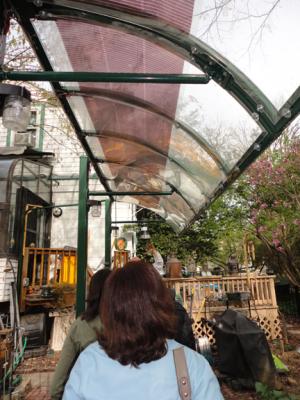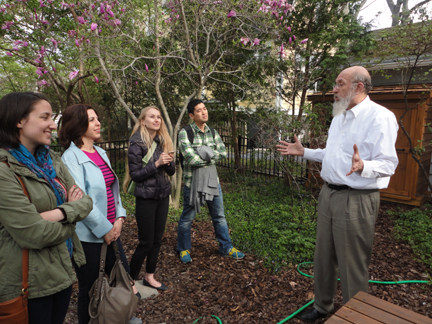On April 18, 2014, a group of EEM faculty and students retreated to a detailed, two-hour tour of the Hall of Dr. Scott Sklar, a member of the Environmental and Energy Management Institute Advisory Board of Advisors.
Scott's home at 706 N. Ivy Street in Arlington, Virginia is 1920’s era Sears kit home that was re-retrofitted in 1985 and again in 1993 to incorporate an incredibly broad array of renewable energy features providing all of the power needs for the home, taking it completely off the grid. Such features include a solar water heating system, a 2.2 kW polycrystalline and thin film photovoltaics system on the upper roof, 0.5 kW of new solar electric peel and stick PV roofing shingles on the front porch roof, and as a solar attic vent fan. The solar system charges a large 24 gel cell glass matrix battery bank and an installation of rear sunroom adds passive solar heating and Virginia’s first electrochromic glass.

The newest addition to Scott’s home is a direct-exchange ground-coupled (geothermal) heat pump. Behind the house, Scott has installed 1 kW of solar electric roofing shingles on his small office building, a 0.5 kW small wind turbine, and a new 2 kW hydrogen fuel cell for summer augmentation power – all charging a smart, web-enabled battery bank. The office building has an efficient ductless heat pump, the newest R 7-9 windows, and incorporates CFLs and bundled LED lighting, a solar daylight tube, and a solar-driven ceiling fan.

Between the buildings is a see-through awning with nanotechnology see-through PV films charging an AGM battery to power LED lighting at night. In addition, the EEM group observed three commercial solar generators and water purifiers, a new 2010 Prius with integrated PV on the roof, and a newly retrofitted education van with high-performance HIT PV, as well as a marine 200 watt wind turbine, a 200 watt fuel cell and a gel-super capacitor battery bank powering a DVD and an all-weather large video screen.
The tour, personally conducted by Dr. Sklar, was incredibly informative, provided an unbelievably comprehensive first-hand look at an extremely broad array of energy conservation and renewable energy technologies.
Terms:
- Kilowatt – is the maximum amount of electricity per hour from an energy system or used by an end user like a homeowner and, US homes range from 5 – 7 kW’s per hour 1,000 kW are a megawatt (MW) or enough power for 150 – 200 US homes Most electric power plants range from 300 – 1,000 MWs.
- R-value is the amount of resistance or insulating value a wall, window or insulation have – meaning the high the value, the more insulating. Most US homes have R-vales ranging between R-11 – R-18, single-pane windows are R-1 and double-pane, argon-filled windows with low-e coatings are R-3.5.
Sklar House:
- R-38 insulation and thermal barrier paint (LO/MIT) in attic.
- CFLs and LEDs in every fixture.
- EnergyStar +++ appliances (Maytag Neptune and Westinghouse Cabrio Washing Machine examples).
- Solar water heater on rooftop.
- Direct-exchange ground-coupled geothermal heat pump (4 copper pipes 100 ft down filled with greenhouse gas friendly refrigerant). Question: Why are there no ducts?
- Solar photovoltaics systems with 24 deep cycle gel cell batteries (SunGel AGM glass matrix – 10 yr warranty) 2 kW polycrystal on upper roof, and .5 kW glassless thin film ‘peal-and-stick’ (UniSolar) on metal-seamed porch roof tied at combiner box into charge controller, batteries, inverter and disconnect, & PV attic vent fan.

- Sunspace (what does awning and tree do ?), with double pane argon-filled, low-e windows and coming, electrochromic glass. Question: What does electricity through the glass do?
Solar Awnings:
- Translucent photovoltaic film charges battery running LED lights between the buildings.
Stella Group Office Building:
- R-50 insulation, super-insulated (nano) windows (Serious Materials) R-7.1 – R9.1 windows.
- LED lights and solar daylight tube into bathroom.
- Solar-driven ceiling fan in conference room and ceiling fan in 2 story area. Question: What are the benefits of ceiling fans?
- Solar roofing shingles (1kW, UniSolar).
- Small wind turbine off building corner (.5 kW SW Windpower).
- PEM fuel cell in rear of building that runs intermittently on recycled industrial hydrogen (2 kW, Reli-On).
Both Buildings:
- Rain barrels – off the corners of each building – recycled rain water in garden.
- Low-flow toilets (conserve water by half) and in house: aerators on sinks and constrictor on shower.
- Composting – people and pet (Geezer & Girtie, Elvis & Cody) food leftovers and wastes, yard clippings, and weeds and tree trimmings, etc.
Outside Generators:
- Solar photovoltaics (PV) area, security, pathway lights – how many do you see ?- and solar bird bath pump aerator.
- Solar greenhouse ventilation fan and weather monitor charger.
- Rooftop pv-foam unit (SunPower/Powerlight) – how is it supposed to be used?
- Solar PV trailer – 3 pv panels of different types, batteries, inverter, charge controller, and sockets photovoltaics – direct conversion of sunlight to electricity pv types – mono crystal, polycrystalline, thin film photovoltaics.
- Hybrid PV/propane homeland security unit (ZeroBase) – movable by large flat bed pickup truck.
- Solar-driven water purification systems (not desalination) 7000 liters- per-day – filters turgid water, heavy metals such as cadmium, and arsenic (3 units in Haiti for Doctors Without Borders, Project Hope).
- Solar thermal panel for water and space heating – cost-effective on 1 million US buildings like your car in the summer when the windows are closed.



